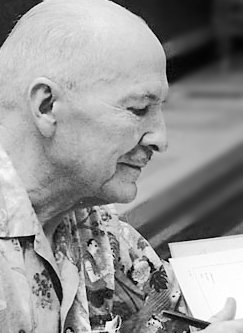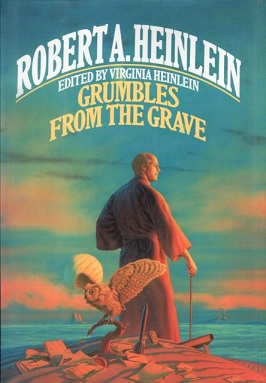Related Research Articles

Robert Anson Heinlein was an American science fiction author, aeronautical engineer, and naval officer. Sometimes called the "dean of science fiction writers", he was among the first to emphasize scientific accuracy in his fiction, and was thus a pioneer of the subgenre of hard science fiction. His published works, both fiction and non-fiction, express admiration for competence and emphasize the value of critical thinking. His plots often posed provocative situations which challenged conventional social mores. His work continues to have an influence on the science-fiction genre, and on modern culture more generally.

Starship Troopers is a military science fiction novel by American writer Robert A. Heinlein. Written in a few weeks in reaction to the US suspending nuclear tests, the story was first published as a two-part serial in The Magazine of Fantasy & Science Fiction as Starship Soldier, and published as a book by G. P. Putnam's Sons on November 5, 1959.

Hanlon's razor is an adage or rule of thumb that states, "Never attribute to malice that which is adequately explained by stupidity." Known in several other forms, it is a philosophical razor that suggests a way of eliminating unlikely explanations for human behavior. It is probably named after Robert J. Hanlon, who submitted the statement to Murphy's Law Book Two (1980). Similar statements have been recorded since at least the 18th century.

Rocket Ship Galileo, a juvenile science-fiction novel by the American writer Robert A. Heinlein, published in 1947, features three teenagers who participate in a pioneering flight to the Moon. It was the first in the Heinlein juveniles, a long and successful series of science-fiction novels published by Scribner's. Heinlein originally envisioned the novel as the first of a series of books called "Young Rocket Engineers". Publishers initially rejected the script, judging going to the moon as "too far out".

Stranger in a Strange Land is a 1961 science fiction novel by American author Robert A. Heinlein. It tells the story of Valentine Michael Smith, a human who comes to Earth in early adulthood after being born on the planet Mars and raised by Martians, and explores his interaction with and eventual transformation of Terran culture.

The Moon Is a Harsh Mistress is a 1966 science fiction novel by American writer Robert A. Heinlein about a lunar colony's revolt against absentee rule from Earth. The novel illustrates and discusses libertarian ideals. It is respected for its credible presentation of a comprehensively imagined future human society on both the Earth and the Moon.

Methuselah's Children is a science fiction novel by American writer Robert A. Heinlein. Originally serialized in Astounding Science Fiction in the July, August, and September 1941 issues, it was expanded into a full-length novel in 1958. The novel is part of Heinlein's Future History series of stories. It introduces the Howard families, a fictional group of people who achieved long lifespans through selective breeding.
"Misfit" is a science fiction short story by American writer Robert A. Heinlein. It was originally titled "Cosmic Construction Corps" before being renamed by the editor John W. Campbell and published in the November 1939 issue of Astounding Science Fiction. "Misfit" was Heinlein's second published story. One of the earliest of Heinlein's Future History stories, it was later included in the collections Revolt in 2100 and The Past Through Tomorrow.
"The Green Hills of Earth" is a science fiction short story by American writer Robert A. Heinlein. One of his Future History stories, the short story originally appeared in The Saturday Evening Post, and it was collected in The Green Hills of Earth. Heinlein selected the story for inclusion in the 1949 anthology My Best Science Fiction Story. "The Green Hills of Earth" is also the title of a song mentioned in several of Heinlein's novels.

Time Enough for Love is a science fiction novel by American writer Robert A. Heinlein, first published in 1973. The work was nominated for the Nebula Award for Best Novel in 1973 and both the Hugo and Locus Awards in 1974.
Lazarus Long is a fictional character featured in a number of science fiction novels by Robert A. Heinlein. Born in 1912 in the third generation of a selective breeding experiment run by the Ira Howard Foundation, Lazarus becomes unusually long-lived, living well over two thousand years with the aid of occasional rejuvenation treatments. Heinlein "patterned" Long on science fiction writer Edward E. Smith, mixed with Jack Williamson's fictional Giles Habibula.
George Edgar Slusser was an American scholar, professor and writer. Slusser was a well-known science fiction critic. A professor emeritus of comparative literature at University of California, Riverside, he was the first curator of the Eaton collection.
Libby as a feminine given name is typically a diminutive form of Elizabeth, which is less commonly spelled 'Libbie' or 'Libi'.

Grumbles from the Grave is a posthumous 1989 autobiography of science fiction author Robert A. Heinlein collated by his wife Virginia Heinlein from his notes and writings.

The Worlds of Robert A. Heinlein is a collection of science fiction short stories by American writer Robert A. Heinlein, published in 1966.
Social science fiction is a subgenre of science fiction, usually soft science fiction, concerned less with technology/space opera and more with speculation about society. In other words, it "absorbs and discusses anthropology" and speculates about human behavior and interactions.

Footprints on Sand: a Literary Sampler is a 1981 collection of writings by science fiction authors L. Sprague de Camp and Catherine Crook de Camp, illustrated by C. H. Burnett, published by Advent. The collection was compiled to celebrate the de Camps' appearance as joint Guests of Honor at the June 12–14, 1981 X-Con science fiction convention in Milwaukee, Wisconsin and was limited to 1000 copies. An ebook edition was issued by ReAnimus Press in February 2021.
Advent:Publishers is an American publishing house. It was founded by Earl Kemp and other members of the University of Chicago Science Fiction Club, including Sidney Coleman, in 1955, to publish criticism, history, and bibliography of the science fiction field, beginning with Damon Knight's In Search of Wonder.
Frank Kramer was an American artist known chiefly for his illustrations for Jack Snow's two Oz books, The Magical Mimics in Oz and The Shaggy Man of Oz, founded on and continuing the famous Oz stories by L. Frank Baum. He also illustrated Robert A. Heinlein's Solution Unsatisfactory, Maureen Daly's Twelve Around the World, and many of Caary Paul Jackson's sports novels for children, including the Bud Baker series.